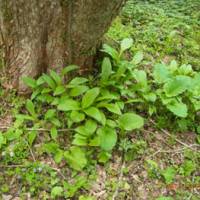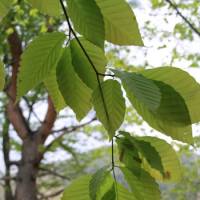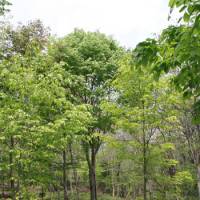The first time that Japan's nature really made me stop, stand, stare and listen, totally lost in wonder, was — I clearly remember — in the early summer of 1963. I'm not so sure where in Japan that wondrous occurence took place, but I know just where I was.
At that time, I hadn't been in Japan very long, having come here in 1962 to study karate. Back then, my Japanese-language skills and knowledge of the country were pretty rudimentary, so when a group of my dojo seniors invited me to join them on a long mountain hike, I'd little or no idea where we were going.
All I remember now is that we boarded an overnight train from Ueno Station in Tokyo, changed to a smaller train in the early hours of the morning, and an hour or so later disembarked at a tiny country station. Now, I think that was probably somewhere in Nagano Prefecture.
The sun was very strong as it rose during the first stage of the hike along a country road between rice paddies. Then we were afforded a little bit of shade on a gravel road that led through plantations of tall cedar and larch. Eventually, at more than 1,000 meters above sea level, we stepped into a cool, crystal wonderland . . . a beech forest.
Coming from Britain, I thought I knew what beech woods were like, but this was far more wild and beautiful than any I'd ever seen. The older trees were massive, the silver-gray bark on their huge trunks mottled with the pastel greens and yellows of lichens. Soaring branches spread like the arches of a huge cathedral; while the sunlight glimmering in scintillating greens was like stained glass come to life. We were surrounded, too, with the sounds of birds and running water, and stepping into that forest was like entering a cool, refreshing, sweetly scented hall.
And there were so many flowers! Carpets of violets and huge patches of white anemone spread under the trees, and here and there among the beeches grew mountain cherry trees with dark-colored trunks as thick as barrels, their spreading branches shedding gently floating petals like confetti at a wedding.
In the years that have passed since then, I have tried to do my share in protecting ancient beech woods here in Japan, but it is a very tough challenge, filled with disappointments, and still continues to be an uphill battle.
Strangely enough I now live in Nagano Prefecture, where I think I may have had that first experience of Japan's natural wonders, and when I began buying up parcels of abused and neglected woodland here in Kurohime with the intention of bringing the woods back to diverse and healthy life, I soon found out that though there were plenty of old beechmast husks in the soil, there were no beeches. They had all been eliminated. For many years it was a Japanese government forestry policy to get rid of beech woods and replace them with conifers.
Today, our woods have lots of beech trees, but the oldest is one that I brought down as a pencil-thin sapling from the side of a mountain path (with permission from the forestry official I was walking with) 28 years ago. That tree is now about 8 meters high, with a circumference of 93 cm around the trunk at waist height.
Yet despite the beech's soaring elegance, many Japanese who live in the countryside have a strange attitude to this tree. The kanji character for the beech includes the symbol for "tree" alongside that for "not" or "nothing." Certainly, whether or not the kanji spawned the attitude, or vice versa, a lot of Japanese feel that the beech is a worthless tree — whereas elsewhere in the world it is highly valued.
In fact, beeches are one of the most important trees for water conservation, as their root-balls soak up rainwater like a sponge and stop it running off downhill, taking soil with it and causing damaging erosion.
Also, because they tend to favor thinner soils, their fluted trunks grow supporting buttresses which — together with the smooth branches and general design of the tree and its foliage — encourage rainwater to flow down the trunks to the thirsty roots. And as in summer they suck up so much water from the ground and evaporate it through their leaves, they are amazing natural coolers and climate modifiers as well.
For wildlife, too, the small three-angled nuts, or beechmasts, of the beech provide invaluable food for many creatures, including bears, wild boar, squirrels, mice and humans. If pressed, beechmast can also yield an excellent and nutritious oil.
Meanwhile, timber from a beech can be steamed and bent to make the curved parts of chairs and other furniture. It makes excellent flooring and is used for all manner of things from bowls to tool handles. As firewood, beech logs are easily split and they burn well, spitting few sparks.
In Britain, beeches are often shaped into hedges, since they respond well to the extreme trimming, cutting and bending this involves. Also, as beeches tend to keep their leaves throughout winter, even when they are brown and dry, a beech hedge makes an excellent windbreak that's almost musical with its rustling.
A beech tree can live for up to 400 years, but as the wood is lacking in tannins and resin, their insides tend to rot out as they grow old — which is excellent for bats, owls and other birds that need these hollows. This natural hollowing-out also probably prolongs the life of an ancient beech because it makes the massive trunk lighter and less liable to be blown over.
I have another use for beech: At this time of the year when the leaves are young and soft, I pick them to enhance salads. I never take too many, just choosing a few from the lower branches. However, the harvesting "window" is very short, because the leaves soon grow tough.
A typical late-spring or early summer salad at my house is made with basic ingredients from the local supermarket. Until late June or early July, our garden doesn't start producing much after the winter snows have gone apart from radishes, so I buy lettuce, tomatoes, celery and cucumbers. Then I go to the woods to gather the strong-tasting, thin green shoots of wild shallots, the fresh green leaves of wild garlic, wild cress and the fresh leaves and white flowers of mountain wasabi from the streams. I might also pick a few young dandelion leaves from the sides of the path and toss them in to add a hint of bitterness.
A well-mixed dressing of balsamic vinegar and olive or grapeseed oil — with the right amount of sea salt and black pepper — finishes it off just fine.
Later on, our salads vary through the summer depending on what we have available in the garden and the woods, but the young beech leaves are only palatable for a week or so.
As I get older, I look forward to wandering in the woods on a hot and sunny day, selecting my spot and sitting on the soft leafy ground with my back against one of the beeches that we ourselves planted, sipping a little wine or a cold beer, reading a book maybe — or just simply daydreaming.
What better way is there to celebrate life, quite unafraid and free, and feeling the woods growing all around you?


















With your current subscription plan you can comment on stories. However, before writing your first comment, please create a display name in the Profile section of your subscriber account page.